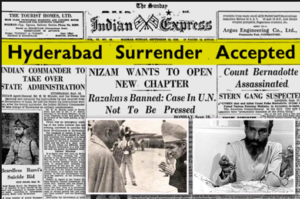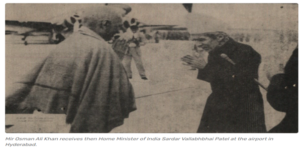Operation Polo completes 75 Years.
Relevance
- GS 1: Modern Indian History from about the middle of the eighteenth century until the present.
- Tags: #OperationPolo #ModernHistory #UPSC #CurrentAffairs #75years #GS1.
Why in the news?
Operation Polo, the military action that integrated the princely state of Hyderabad into India, marked its 75th anniversary on September 13, 2023. This operation ended the Nizam of Hyderabad’s bid for independence and brought an end to the threat of secession.
Establishment of Hyderabad State (1724)
- Nizam-ul-Mulk Asaf Jah founded Hyderabad in 1724, covering much of the Deccan plateau.
- It grew in popularity and prosperity, boasting its own army, railways, airlines, postal system, and radio network.
- Hyderabad had a diverse population, with 85% of its subjects being Hindus.
British Protection (1798)
- In 1798, Hyderabad was the first royal state to accept British protection under the Subsidiary Alliance policy.
Post-Independence Choices for Princely States
In 1947, as the British left India, princely states were given options to join India, Pakistan, or remain independent.
Nizam’s Opposition to Integration
- The last Nizam of Hyderabad, Osman Ali Khan Asaf Jah VII, opposed merging Hyderabad with India after Independence.
- He declared Hyderabad as an independent nation on August 15, 1947.
Heads of Agreement Proposal (June 1948)
- In June 1948, Lord Mountbatten proposed the Heads of Agreement deal, offering Hyderabad the status of an autonomous dominion nation within India.
- India agreed to sign the deal, but the Nizam refused.
- He insisted on complete independence or the status of a dominion within the British Commonwealth of Nations.
Background of Operation Polo
Nizam’s Independence Aspirations
- The Nizam of Hyderabad, Mir Osman Ali Shah, aimed to maintain Hyderabad as an independent entity
- He did not want to join India or Pakistan after Independence in 1947.
Opportunity Amidst Kashmir Conflict
- The Nizam took advantage of the Indian government’s involvement in the Kashmir issue shortly after India gained independence.
- India’s efforts and attention were focused on countering the danger posed by Pakistan in Jammu and Kashmir.
Standstill Agreement
- In November 1947, the Nizam entered into a standstill agreement with India.
- This agreement essentially maintained the status quo between India and Hyderabad, deferring any decision on the state’s future.
- The agreement established that for one year, India would not exert authority over Hyderabad, and prevailing conditions would persist.
Why was Operation Polo launched on September 13, 1948?
- Rising Tensions in Hyderabad – Hyderabad, located in the Deccan region, was a wealthy and populous state with 17 districts, including Aurangabad and Gulbarga (now in Maharashtra and Karnataka, respectively).
- Religious and Administrative Divide – Hyderabad had a Hindu-majority population but was primarily administered by Muslim rulers. This religious and administrative divide created a complex situation.
- Intentions of the Nizam – The Nizam of Hyderabad intended to maintain friendly relations with Pakistan, even though there was no common border with Pakistan.
- Rise of Razakars – Hyderabad’s administration took advantage of the standstill agreement with India to strengthen the irregular force known as the Razakars, led by Maj Gen SA El Edroos.
- Razakar Excesses – The Razakars committed excesses against the predominantly Hindu population, causing fear and unrest. They conducted cross-border raids, adding to tensions.
- Secession Threat – The Nizam’s overtures to Pakistan and the intention to establish an independent nation within India’s heartland raised concerns about potential secession.
- Launch of Operation Polo – In response to these developments and the threat of secession, the Indian government launched “Operation Polo” on September 13, 1948, to address the situation and integrate Hyderabad into India.
Nizam’s Forces vs. Indian Army
Strength of Hyderabad State Forces
- Hyderabad state had approximately 25,000 troops, but only a fraction of them were well-trained and capable.
- The opposition forces in Hyderabad were estimated to be less than two brigades in size.
- There were a significant number of Razakars, but they were poorly trained and more of a nuisance than a serious military threat.
The Nizam’s Boastful Claim
- The Prime Minister of Hyderabad, Mir Laik Ali, had boasted that if the Indian Army intervened, they had a force of 1,00,000 troops ready to defend the state.
Outcome of Operation Polo
- Despite the Nizam’s claims, the Hyderabad opposition to the Indian Army crumbled within the first two days of the offensive.
- Indian forces, under the leadership of Maj Gen Jayanto Nath Chaudhuri, quickly gained control and integrated Hyderabad into the Indian Union.
Operation Polo Ground Strategy
Western Strike Led by 1 Armoured Division
- Primary Strike: The primary attack came from the west, led by Maj Gen Chaudhuri’s 1 Armoured Division.
- Composition: This strike included 1 Horse (minus one squadron) and 9 Dogra (minus one company) units.
- Smash Force: A special force called Smash Force was formed, comprising 3 Cavalry, 17 Horse (minus one squadron), and one company of 9 Dogra.
- Kill Force: The Western thrust also included a Kill Force commanded by 7 Infantry Brigade. It consisted of 2 Sikh, 1 Grenadier, 14 Rajput, and one squadron of 14 Horse.
- Vir Force: Another component of the Western attack was the Vir Force, led by 9 Infantry Brigade, 3/2 Punjab, and 2/1 Gorkha Rifles.
Additional Thrusts from Different Directions
- Aurangabad Axis: A separate thrust was launched from the Aurangabad axis, involving 4 Rajputana Rifles, 3/5 Gorkha Rifles, 17 Sikh, and ad hoc tank and armored car units.
- Northern Push: The northern advance was commanded by Jabalpur (Independent) Sub Area, with units like 18 Cavalry, 2 Jodhpur, 7/2 Punjab, 3 Sikh, and a company of central police.
- Eastern Advance: The eastern advance into Hyderabad was led by 2/5 Gorkha Rifles, 6 JAT, 6 Kumaon, 9/2 Punjab, 3 Sikh Light Infantry, and one squadron of 17 Horse.
- Southern Thrust: The southern thrust from Vijayawada consisted of 5/5 Gorkha Rifles, Mysore Lancers, and 1 Mysore Infantry.
Execution of Operation Polo
- Operation Polo was executed by converging these multiple thrusts from various directions into Hyderabad state.
- This strategic approach overwhelmed the Nizam’s forces and quickly led to the integration of Hyderabad into the Indian Union.
Surrender of Hyderabad Forces
- Ceasefire Announcement: The Nizam of Hyderabad declared a ceasefire on September 17.
- Entry of Indian Forces: On September 18, Maj Gen Chaudhuri and his forces entered Hyderabad city.
- Maj Gen El Edroos, the head of Hyderabad forces, surrendered to Maj Gen Chaudhuri.
- Military Governance: Maj Gen Chaudhuri was subsequently appointed as the Military Governor of Hyderabad.
Ashoka Chakra Award
- Havildar Bachhitar Singh of 2 Sikh received the first Ashoka Chakra of Independent India posthumously.
- He sacrificed his life on September 13, 1948, during the advance to Naldurg, which was part of Hyderabad state at the time but is now in Maharashtra.
Operation Polo, launched 75 years ago, was a significant military action that integrated the princely state of Hyderabad into India. It was a pivotal moment in India’s post-independence history, ending the Nizam’s bid for independence and ensuring the state’s integration into the newly formed Indian Union. The operation’s success underscored India’s commitment to preserving its territorial integrity and upholding the principles of democracy and unity.
Source: Indian Express, The Hindu
Mains Question
Discuss the historical significance of Operation Polo in the context of India’s post-independence history. How did the integration of the princely state of Hyderabad into the Indian Union impact the governance and territorial integrity of India?





